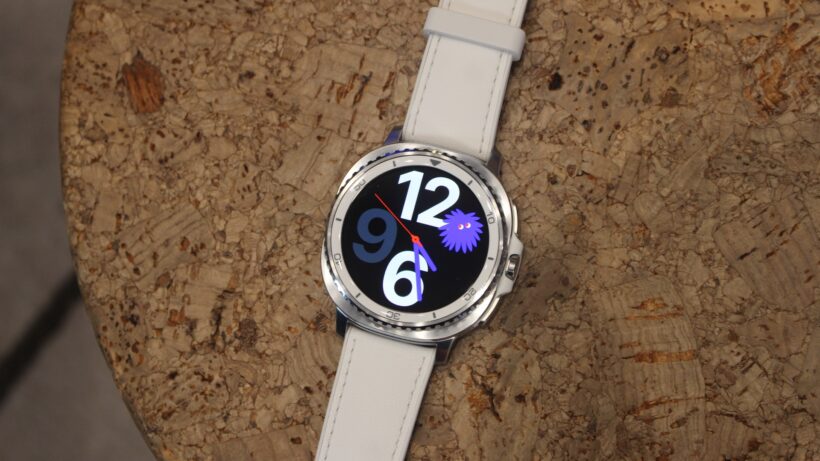After leaving the Classic line out in the cold last year, Samsung’s smartwatch with a rotating bezel is back for the brand’s Galaxy Watch 8 series.
It’s leaked extensively over the last few months, meaning its return is no surprise. It also confirms that Samsung will continue its previous practice, with a two-year rotating cycle for its premium editions, despite the Ultra’s debut last year.
Although, as we’ll explore, the latest relationship between the constantly-swapping premium versions is a little different from when the ‘Pro’ model was around. Instead, the $499/£449 Galaxy Watch 8 Classic is more than a little inspired by last year’s Galaxy Watch Ultra.
Semi-confusingly, Samsung has also updated the Ultra line for 2025—now calling it the Galaxy Watch 8 Ultra—but this is no more than a rebadging. There’s been an increase in storage and a fresh lick of paint, but it’s not a wholesale second-gen update.
So, it’s the Watch 8 series that takes centre stage this time around. And when it comes to the Classic edition, those leaks haven’t revealed everything. After some hands-on time, we think there’s lots more to this update than the bezel that surrounds the Super AMOLED display
Design and display: Seriously Ultra-inspired

The new Classic is probably best described as a cross between the last version that launched (the Galaxy Watch 6 Classic) and the Galaxy Watch Ultra.
The showy bezel and smart leather strap are nods to its classic, timepiece-influenced design roots, and are joined by a change in shape to what Samsung calls its ‘cushioned’ case design—and everyone else calls a ‘squircle’.

It’s a smaller squircle, landing in just a 46mm size, so just shy of the 47mm Ultra. However, as is clear from the side-by-side comparison above, these are very similar watches.
The design nods don’t end with the large footprint, either, as Samsung is also bringing over its Quick Button. This works in the same way as before, providing you with shortcut access to features like a flashlight and workout tracking.
A brightness boost
The Super AMOLED touchscreen display is also improved. Samsung has stepped things up in the nits department to make this a brighter display than what we’ve seen on previous Samsung smartwatches, too, with the Galaxy Watch 8 series devices both featuring 3,000-nit displays.
Flip the Classic over, and you’ll see that Samsung has also introduced the Ultra’s lug connector to make it easier to switch straps in and out.
Crucially, despite integrating those touches from the Ultra line, this still feels like a Galaxy Watch Classic at heart—mostly, we think, thanks to the rotating bezel, which is still as pleasing as ever to twist to scroll through menu screens and widgets. Still, it’s hard to ignore how much Samsung has drawn inspiration from its more outdoor-centric smartwatch to inform the look of the new Classic.
Software: Google’s AI makes its debut

Samsung’s close relationship with Google means its smartwatches get early access to the latest version of its smartwatch platform, Wear OS 6. The Classic features Samsung’s One UI Watch 8 on top, along with a new chipset to ensure smooth operation.
While it was a little challenging to see a tangible difference when moving from Wear OS 4 to 5 last year, the experience does feel fresher with this latest update.
We’re now seeing what Samsung refers to as ‘depthless notifications’ when swiping through the interface. A new bar-shaped UI element, inspired by the Galaxy S25 smartphone, also aims to make it easier to keep an eye on other features running in the background.

One of the most interesting UI changes is that the Tiles (widgets) are now presented in feeds, and they feel very much like Garmin Glances in their presentation.
Google Assistant is dead, long live Google Gemini
The headline software feature is that this is the first smartwatch series to launch with Google Gemini.
I had a quick demo of how I could ask Gemini to generate a healthy pasta meal or start a workout, and it certainly seemed to respond in a more than breezy fashion compared to Google’s Assistant, which has been slowly phased out over the last year or so.

For runners, there’s now a personalized running coach feature, where you’ll initially complete a 12-minute running test and receive a grade. Once you input your running goals into the Samsung Health app, it will build a plan that can dynamically adjust based on your progress.
New tracking features

Building on the software refresh, Samsung is also debuting a ton of new tracking features with this latest generation.
One feature that caught our attention during our brief hands-on time was the ‘Antioxidant Index’, which builds on Samsung’s already extensive array of health-focused features, such as the AGEs Index that debuted last year.
This one works by placing your thumb on Samsung’s BioActive sensor on the case back for 5 seconds, where it measures carotenoids and generates an index that determines your antioxidant level as high or low.
If it’s high, it can be an indicator that you’re slowing down the signs of aging. If it’s low, the Health app will offer recommendations to help boost it, such as eating a banana or two. We’re intrigued to see how this fluctuates over more long-term testing, and whether the insights are truly helpful.
There’s more on the health and wellness front, too.
The Classic features new ‘Vascular Load’ insights that determine stress on the user’s circulatory system overnight, ‘High Stress Alerts’ to help users become more aware of real-time body responses, and ‘Bedtime Guidance’ to support a healthy sleep routine.
This all-new sleep feature activates after a few nights’ sleep and helps suggest optimal bedtime and wake times for users. Meanwhile, Samsung has announced that its sleep apnea tracking is now available in the UK with the arrival of the Watch 8 series.
Initial verdict

The rotating bezel is king among Samsung smartwatch fans, and our first impressions are that the brand has done an elegant job of tying the classic design feature back into a refreshed look.
Yet, this is much more than just a design update. The slick-looking, more substantial Wear OS 6 update, joined by several health and wellbeing insights (some of which aren’t offered by any of the competition), means Samsung might have just delivered the best Android smartwatch of 2025 here.
However, the proof is always in the testing. While we like what we see so far, talk of an 8% battery improvement doesn’t sound all that promising. And, as ever, whether those new insights and tracking features prove both accurate and valuable in the longer term also remains to be seen.
Stay tuned for our full verdict on the $499/£449 (or $549/£499 for the LTE model) Galaxy Watch 8 Classic in the coming weeks; we’ll tell you whether this is one worth paying for or whether you’re better off elsewhere.




